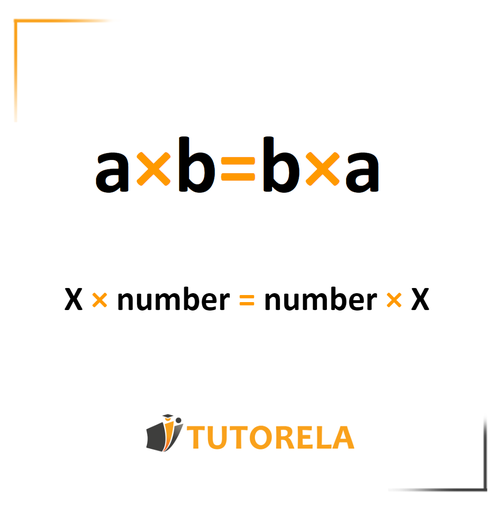Let's see an example:
X×2=2×X
We can replace the X with a number:
X=3
We get:
2×3=6
3×2=6
As you can see, it doesn't matter in what order we multiply the factors, we still get the same correct answer.
Note that the commutative property of multiplication does not work with division.
Starting to get it? Keep practicing to turn this new property into muscle memory.
Exercises with the commutative property of multiplication
Exercise 1
Task:
5.25⋅32⋅217=?
Solution:
First, we convert the decimal number into a mixed fraction.
541⋅32⋅217=
Then, we convert the mixed fraction into a simple fraction.
45×4+1⋅32⋅217=
421⋅32⋅217=
Notice that you can reduce to 21 and get a simpler expression.
47⋅32=
We multiply the numerator by the numerator and the denominator by the denominator.
4×37×2=
1214=
We continue to reduce as much as possible.
1122=
161
Answer:
161
Join Over 30,000 Students Excelling in Math!
Endless Practice, Expert Guidance - Elevate Your Math Skills Today
Exercise 2
Task:
441⋅394⋅3171=?
Solution:
First, we convert all mixed fractions to simple fractions.
44×4+1×93×9+4×173×17+1=
416+1×927+4×1751+1=
417×931×1752=
We reduce to 17
452×931=
We divide 52 by 4 and solve
13×931=
9403=4497
Answer:
4497
Exercise 3
Task:
(7+2+3)(7+6)(12−3−4)=?
Solution:
We start by solving each of the parentheses in the order of operations.
(9+3)×13×(9−4)=
12×13×5=
We move the 5 to the left so that we can easily solve the exercise from left to right
12×5×13=
60×13=780
Answer:
780
Do you know what the answer is?
Exercise 4
Task:
5⋅7⋅13⋅6=?
Solution:
We reorder the exercise into two smaller expressions so that they are simpler to solve.
7⋅13⋅6⋅5=
We start by solving the first expression in the exercise, and then the second.
Then we solve the whole, simplified expression.
91⋅30=2730
Answer:
2730
Exercise 5
Task:
5⋅17⋅2=?
Solution:
We reorder the exercise to make it easier to solve.
5⋅2⋅17=
We continue solving the exercise from left to right.
10⋅17=170
Answer:
170
Review questions
What is the commutative property in multiplication?
The commutative property of multiplication tells us that changing the order of the factors in an expression won't change the end result
For example, we will get the same answer if we multiply 3×16 or if we multiply 16×3, in both cases the result is 48.
How does the commutative property work in multiplication?
The commutative property in multiplication can be understood as follows: a×b=b×a
This means that the order of the factors does not change the result. If we assign values to a=4 and b=6, applying the commutative property we will get:
4×6=24
6×4=24
We can see that in both cases it gave us the same result even though the factors are in a different order.
What are the 4 properties of multiplication?
The 4 properties of multiplication are the following:
- Commutative: No matter the order of the factors, the result will be the same a×b=b×a
- Associative: No matter how we group sets of factors, the result will be the same. a×(b×c)=(a×b)×c
- Distributive: Multiplying a factor by the sum of two addends is the same as multiplying by each addend separately and then adding the results together. a×(b+c)=a×b+a×c
- Identity element: The identity element of multiplication is 1, because if we multiply a number by the number 1, the result will still be that number. This can be understood as follows a×1=a.
Do you think you will be able to solve it?
Examples with solutions for The Commutative Property of Multiplication
Exercise #1
Solve the following problem:
15×2×8=
Video Solution
Step-by-Step Solution
Since the exercise involves only multiplication, we will use the commutative property to simplify the calculation:
2×15×8=
Now let's solve the multiplication on the right:
15×8=120
We obtain the following expression:
2×120=240
Answer
Exercise #2
Solve the following exercise:
5+14+5= ?
Video Solution
Step-by-Step Solution
Since the exercise only involves addition, we will use the commutative property to calculate more conveniently:
5+5+14=
We will then solve the exercise from left to right:
5+5=10
10+14=24
Answer
Exercise #3
Solve the following exercise:
8+9+2= ?
Video Solution
Step-by-Step Solution
Since the exercise only involves addition, we will use the commutative property to solve it.
8+2+9=
Now let's solve the exercise from left to right:
8+2=10
10+9=19
Answer
Exercise #4
Solve:
−5+4+1−3
Video Solution
Step-by-Step Solution
According to the order of operations, addition and subtraction are on the same level and, therefore, must be resolved from left to right.
However, in the exercise we can use the substitution property to make solving simpler.
-5+4+1-3
4+1-5-3
5-5-3
0-3
-3
Answer
Exercise #5
Video Solution
Step-by-Step Solution
According to the order of operations, we first solve the division exercise:
4:2=2
Now we obtain the exercise:
2+2=4
Answer










